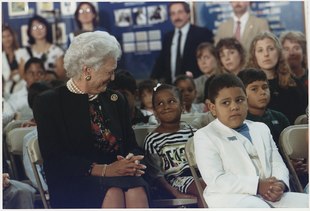This article may need to be rewritten to comply with Wikipedia's quality standards, as article. (June 2024) |

The most recent comprehensive data on adult literacy in the United States come from the Program for the International Assessment of Adult Competencies (PIAAC) study conducted in stages from 2012 to 2017 by the National Center for Education Statistics (NCES). English literacy test results from 2014 suggest that 21% of U.S. adults ages 16 to 65 score at or below PIAAC literacy level 1, meaning they have difficulty "[completing] tasks that require comparing and contrasting information, paraphrasing, or making low-level inferences." Included in that 21% is the 4.2% of respondents who were unable to be assessed due to language barriers, cognitive disability, or physical disability.[1] A 2020 study by the Gallup analysis company funded by the Barbara Bush Foundation for Family Literacy estimated that getting all U.S. adults to at least PIAAC literacy level 3 proficiency would raise American's incomes by $2.2 trillion.[2]
The United States Department of Education also assesses literacy in the general population through its National Assessment of Adult Literacy (NAAL).[3] The NAAL survey defines three types of literacy:[4]
- Prose: the knowledge and skills needed to search, comprehend, and use continuous texts. Examples include editorials, news stories, brochures, and instructional materials.
- Document: the knowledge and skills needed to search, comprehend, and use non-continuous texts in various formats. Examples include job applications, payroll forms, transportation schedules, maps, tables, and food and drug labels.
- Quantitative: the knowledge and skills required to identify and perform computations, either alone or sequentially, using numbers embedded in printed materials. Examples include balancing a checkbook, figuring out tips, completing an order form, or determining an amount.
Modern jobs often demand a high literacy level, and its lack in adults and adolescents has been studied extensively. A number of reports and studies are published annually to monitor the nation's status, and initiatives to improve literacy rates are funded through both governmental and external sources.[5]
- ^ "Adult Literacy in the United States". nces.ed.gov. Retrieved 2024-11-13.
- ^ Cite error: The named reference
:4was invoked but never defined (see the help page). - ^ "National Assessment of Adult Literacy (NAAL)". National Center for Education Statistics. Archived from the original on September 22, 2019.
- ^ Cite error: The named reference
NCESLiteracyTypes2003was invoked but never defined (see the help page). - ^ Goldin, Claudia; Katz, Lawrence F. (1999). "The shaping of higher education: The formative years in the United States, 1890 to 1940". Journal of Economic Perspectives. 13 (1): 37-62. doi:10.1257/jep.13.1.37.
